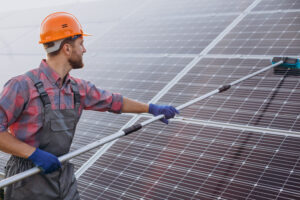The Kerala Cabinet approved ‘Guidelines on Development of Floating Solar Power Plants’ to advance renewable energy production and fulfill sustainability goals through the state’s inland water bodies.
The new rules, prepared to enable the Kerala Solar Energy Policy, see the employment of reservoirs, backwaters, quarries, and other water bodies as sites for placing floating solar farms. The vision is to provide 3 gigawatts (GW) of renewable energy capacity, a critical milestone for the state to transition to clean and green energy.
A New Model for Sustainable Development
ANERT has been identified as the state-level coordinating organization for commissioning the floating solar system. A high-powered state-level committee with the Chief Secretary as chairperson would be constituted for successful implementation and monitoring. District-level committees with the District Collectors as chairpersons would also be constituted to oversee the identification and development of suitable locations for installation.
The respective district-level entities shall be made accountable for designing ‘land banks’ of prospective locations through the identification of privately owned and government-owned bodies suitable for appropriate floating solar farms.
Developer Eligibility and BOO Model
To ensure that only competent players join, developers will have to have prior experience in power generation. Specifically, they must already have an existing power plant with a capacity of at least one-third the capacity of the proposed floating solar project. All projects will use a Build-Own-Operate (BOO) model.
Further, developers are encouraged to include energy storage systems for up to 50% of the generated energy. This move will help Kerala overcome one of the greatest challenges in solar power, i.e., intermittent supply, by enabling better load management and grid stability.
Classification of Sites and Potential Capacity
The guidelines established two distinct categories for project development:
Category A: Department of Water Resources and Kerala State Electricity Board (KSEB) reservoirs. With only 10% utilization of their surface area available, the reservoirs would be able to supply electricity worth 5,000 megawatts (MW).
Category B: It consists of backwaters, freshwater bodies created as a result of the quarrying and mining process, and uncultivable or salt lands. They can contribute another 1,500 MW, again using only 10% of the entire water surface.
These categories not only consider ecological sensitivity but also demonstrate the huge untapped potential hidden in Kerala’s water bodies.
Simplified Application Process Through a Single Window System
To facilitate approvals and encourage investment, the government will put in place a single-window clearance system. It will make the different departments’ approvals more streamlined and monitor the approval status, hence being transparent and quick to implement.
Developers can submit applications in three modes:
- Applications on Notice Inviting Tender (NIT) or Expression of Interest (EOI) by government entities.
- Suo motu proposals by developers to submit feasible floating solar locations.
- Applications for project proposals on properties that are included in the official land banks.
Power Purchase Prioritization
As a part of the solar policy, the KSEB will be provided with the right of first refusal to buy electricity produced by these projects. In situations where the floating solar systems are to be installed in reservoirs of the Water Resources Department or Kerala Water Authority, the departments will enjoy the first right, followed by the KSEB. This guarantees that the power produced is utilized properly within the public infrastructure and utilities of the state.
Future-Proofing via Pumped Storage and Green Hydrogen
The regulations serve not just the short-term needs of energy but also find themselves integrated into Kerala’s sustainability agenda in the long run. Solar plans over water bodies, as the report also notes, can be coupled with Pumped Storage Projects (PSPs) at hydel dams. PSPs will be giant batteries, storing power during the day using excess solar energy by pumping water up and releasing it to generate electricity when the need arises.
Besides this, power from floating solar farms can also be harnessed to generate green hydrogen through electrolysis — a chemical process that employs electricity in an attempt to split water into hydrogen and oxygen. This puts Kerala on the map to become a center of hydrogen-based fuel systems, which is a technology that is set to shape the decarbonization of such industries as heavy industry and transport.
“Green hydrogen by electrolysis can be realized through the utilization of the power produced by these plants. Here, it is a proposal of greater and longer-term implications,” the guidelines further state.
Authorities Watch and Support Implementation
The participation of the highest-level administrative authorities, like the Chief Secretary, District Collectors, and other Government departments, demonstrates the Government’s serious interest in monitoring and speeding up the projects. This interdepartmental coordination and governmental monitoring are likely to reduce delays, stimulate private investment, and bring about greater transparency.
A Brighter Future for Kerala’s Solar Industry
The draft guidelines are a pathbreaking initiative in redesigning Kerala’s renewable energy sector. By accessing lesser-used and non-agricultural water bodies, the state is not just evading land-use conflicts but also bringing climate-resilient energy opportunities.
As the government becomes increasingly friendly and there is increasing demand for clean power, floating solar can quite conveniently become a popular source of electricity in Kerala that can help fuel employment, investments, and economic growth in a green manner.
As Kerala looks to the future, it may be the technology that rises above the rest, both figuratively and literally.






